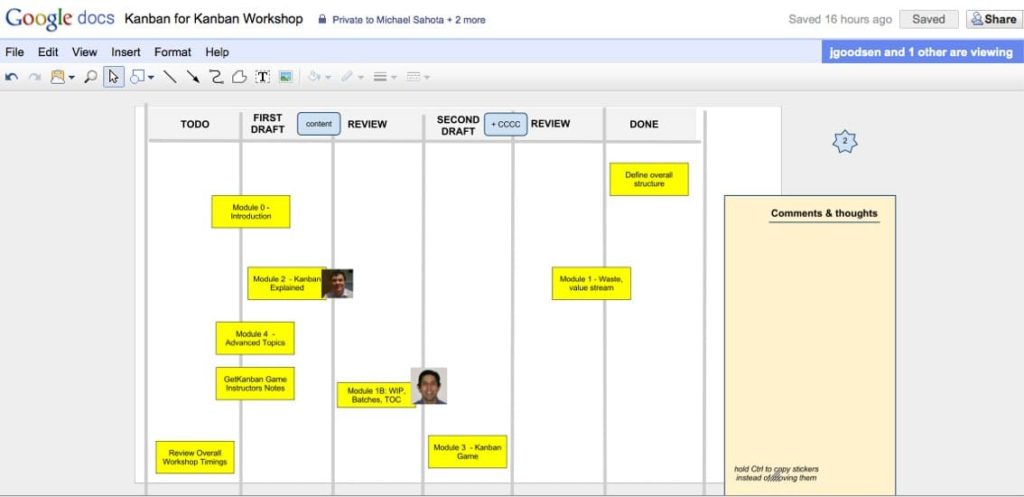John Goodsen and I set out to deliver a great one day Kanban workshop as part of Agile Tour Toronto 2010 and we hit this one out of the park.
What People had to Say about the Training
- “Engaging, Practical, Fundamental I liked the flow from concepts to games/practice; moved quickly; teamwork/collaborative learning.” – Alex Zeldin, Manager Planning and Business Solutions
- “Wicked, Awesome, Cool I liked the games and the Q&A session at the end.” – Trevor Ramoutar, Project Manager
- “Interactive, Informative, Practical A very lively workshop – you could feel the experience the trainers have! Thanks a lot.” – Hedi Buchner, ScrumMaster and coach.
Recipe for Success
- Two coaches who have different experiences, points of view and are ready to experiment (See: Agile Coaches are like Superheroes)
- A strong desire to apply Training from the Back of the Room (See: Thought you were a good trainer? Guess Again!)
- A group of motivated learners
How I trained from the back of the room and loved it
If you are unfamiliar with this book, please check out my book review and mindmaps.
Below are the exercises we use from the book. Most of what we used was from Connections and Conclusions. We played lot’s of games for concrete practice. We had limited use of slides (see bottom of page) to illustrate concepts. My overall take is that we covered less and did it with much higher quality.
Introduction
Connections – “PostIt/What’s in it for me?” (p.99)
- Hand draw poster with “What’s in it for me?”
- As people arrive, have them write WIIFM on PostIts with their Name.
Connections – “Think then Ink” (p.98) + Knowledge line
- “Think about what you already know about this topic. Write three facts on an index card.
- Form a line from most to least knowledgable about Kanban/Agile to least.
- Share your facts on index card with your neighbours.
- In a line from least to most, everyone can share one thing with the class
Lean: Waste & Value Stream Mapping
Connections – Card Carousel (p.106) – 2 minutes
- Pass around cards with topics written on them: Value Stream Mapping, Muri, Mura, Muda, Value, Toyota Production System, Waste
Oops – forgot to integrate cards when reviewing material.
Idea – Would have been good to have people make notes during waste discussion of what they have seen in their workplace and then make a top 10 list.
Flow Basics
Connections – Table Talk (p.105)
- In pairs (or triple), decide what is more important (rank/order them): (3 min)
- Reducing multitasking
- Smaller batches
- Identifying bottlenecks
- Share with class (3 min)
Conclusions – same exercise as at the beginning. Wow, what great discussion. People really remember this part.
Closing of the Day
Evaluation – Where do you stand? (p 221)
- How comfortable to you feel with the material? Stand where you are.
- Ready to roll — On the way — Not quite yet
- Take 3-5 minutes for pair/triad discussion.
- Report back to larger group
Get Kanban Game
The whole workshop was organized around playing Russell Healy’s GetKanban Game in the afternoon. The morning was all about layering in basic lean concepts followed by a quick intro to Kanban – just enough to play the game. Afterwards, we covered various topics through parking lot (Q&A).
I give the game a thumbs up and will definitely use it again. One important note that John and I clued into is that the game presupposes that people understand breaking work into small batches/tickets and limiting work in process. That’s why we played several games in the morning to establish the basics of flow. See slides for specifics.
Slides
Eating our own dog food
Yes, John and I eat our own dog food. We used Kanban to visualize the work we needed to do to prepare for the workshop. Below is a snapshot of our Kanban board we created in google docs. See Henrik Kniberg’s sample.

Thanks
John and I would like to thank everyone who shared material with us to prepare our slides – notably Henrik Kniberg, Mary Poppendieck and Jon Stahl.
I would also like to thank Russell Healy for discussions on rule variants of the Kanban Game.


